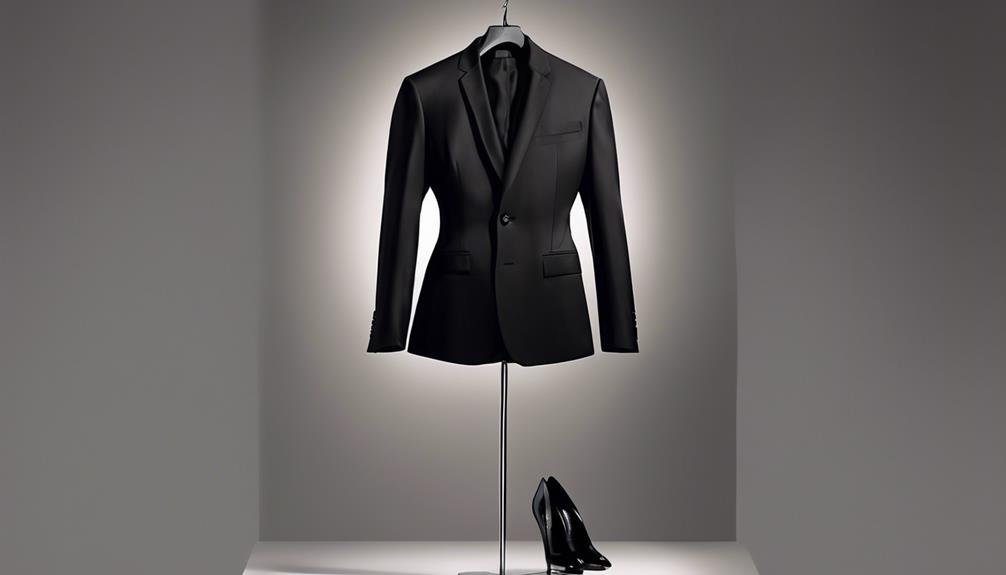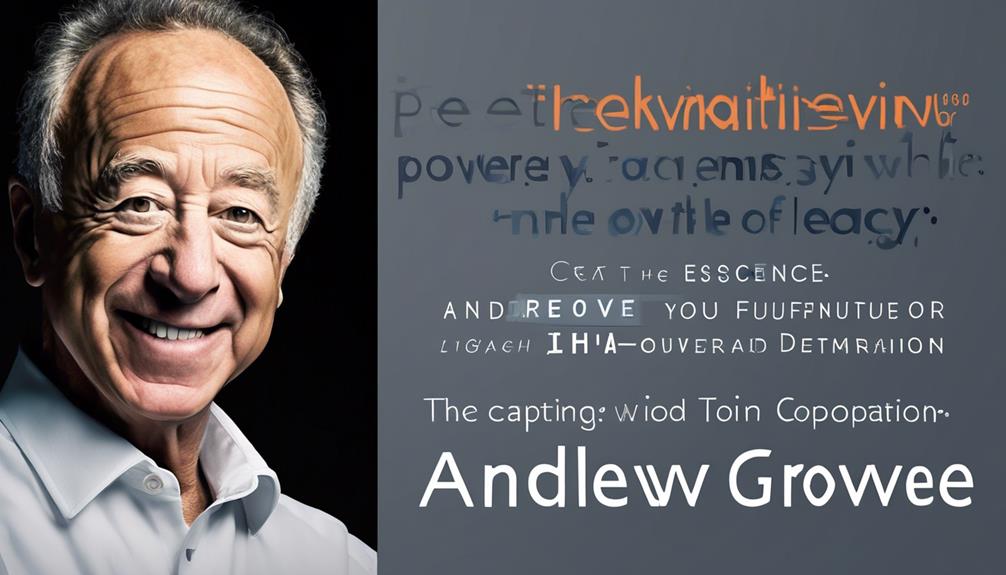Giorgio Armani, the illustrious Italian fashion icon, has undeniably made a lasting impact on the fashion industry. It might come as a surprise that his path to triumph wasn’t always a walk in the park. Initially beginning his career as a window dresser, it was Armani’s fervor and resolve that elevated him to become among the most pivotal personalities in the realm of fashion.
With his signature clean lines and understated elegance, Armani revolutionized the way we think about fashion. His quotes offer valuable insights into his creative process and philosophy, emphasizing the importance of simplicity, individuality, and confidence.
Join us as we delve into the wisdom of Giorgio Armani, exploring the enduring impact of his designs and the timeless beauty they exude.
Key Takeaways
- Simplicity and minimalism are essential for creating timeless elegance and sophistication in fashion.
- Individuality and personal style should be celebrated and embraced in fashion.
- Fashion is a powerful form of self-expression and can boost confidence and self-esteem.
- Armani is committed to sustainability and uses quality materials in their designs.
The Importance of Simplicity
Simplicity is a fundamental aspect that Giorgio Armani emphasizes in his design philosophy, believing that it's essential for creating timeless elegance and effortless sophistication. Armani is known for his minimalist approach to fashion, where less is more. He believes that simplicity in design allows the true essence of the garment to shine through, without distractions or unnecessary embellishments.
Armani's minimalist fashion aesthetic is characterized by clean lines, neutral colors, and understated elegance. He believes in creating pieces that are timeless and versatile, allowing them to be worn for years to come. By stripping away excess details and focusing on the essential elements, Armani creates designs that are both sophisticated and understated.
His commitment to simplicity extends beyond the design process. Armani believes in creating a seamless and effortless experience for his customers. From the layout of his stores to the packaging of his products, everything is carefully curated to reflect his minimalist aesthetic.
In a world that's constantly changing and evolving, Armani's emphasis on simplicity is a breath of fresh air. His minimalist approach to fashion allows for timeless elegance and effortless sophistication, making his designs truly stand the test of time.
Embracing Individuality and Personal Style

When it comes to personal style, Giorgio Armani believes in celebrating individuality and unique style expression. He understands the importance of self-expression and encourages people to embrace their own personal style instead of following trends blindly.
Armani's designs are known for their timeless elegance, allowing individuals to showcase their personality through their clothing choices. Embracing individuality and personal style is a way to stand out and make a statement in the world of fashion.
Unique Style Expression
Embracing our individuality and personal style is essential in expressing our unique fashion sense. As Giorgio Armani once said, 'Elegance isn't standing out, but being remembered.'
Our style evolution is a constant process of self-discovery and self-expression. It's through this evolution that we find our own distinctive fashion voice. Fashion innovation allows us to push boundaries and challenge conventional norms.
It's about experimenting with different styles, fabrics, and cuts, and incorporating them into our personal style. By embracing our individuality, we create a sense of authenticity that sets us apart from the crowd.
Our style becomes a reflection of our personality, values, and aspirations. It's through this unique style expression that we make a lasting impression and leave a mark in the world of fashion.
Celebrating Self-Expression
By embracing our unique individuality and personal style, we empower ourselves to celebrate self-expression in the world of fashion.
Self-expression through art is a powerful way to communicate our thoughts, emotions, and identities. It allows us to showcase our creativity and share our unique perspectives with the world.
Fashion is a form of art that enables us to express ourselves and embrace diverse identities. Whether it's through our clothing choices, accessories, or overall style, fashion gives us the freedom to experiment and explore different aspects of our personality. It allows us to break free from societal norms and express our true selves authentically.
Embracing individuality and personal style in fashion isn't only empowering but also inspires others to embrace their own unique self-expression.
Fashion as an Expression of Confidence
Fashion serves as a powerful means of conveying confidence, allowing individuals to express their self-assuredness through their personal style choices. When we dress in a way that aligns with our authentic selves, it boosts our self-esteem and reinforces our sense of identity. Fashion becomes a form of self-expression and empowerment, enabling us to communicate our inner strength to the world.
By wearing clothes that make us feel good about ourselves, we enhance our self-image and cultivate a positive mindset. The right outfit has the potential to transform our attitude and outlook, giving us the confidence we need to navigate any situation.
Through fashion, we have the freedom to experiment with different styles, colors, and silhouettes that reflect our personality and individuality. By embracing our unique fashion choices, we break free from societal expectations and embrace our own power, creating a sense of liberation and empowerment.
The Power of Quality Materials

Quality materials are essential for creating garments that not only exude elegance and sophistication but also stand the test of time. As fashion enthusiasts, we understand the importance of investing in clothing made from sustainable fashion practices and sourced ethically.
Giorgio Armani, the renowned Italian fashion designer, shares our belief in the power of quality materials. Armani's commitment to sustainable fashion practices is evident in his brand's use of eco-friendly materials. By incorporating recycled or organic fabrics, he not only reduces environmental impact but also supports ethical sourcing and production. This commitment to sustainability aligns with the desires of our audience, who seek mastery in fashion while also considering the planet.
When it comes to creating timeless designs, quality materials play a pivotal role. Armani's attention to detail and impeccable craftsmanship ensure that his garments withstand the test of time. By using luxurious fabrics such as silk, cashmere, and fine wool, he creates pieces that exude sophistication and elegance.
Innovation and Evolution in Fashion

When it comes to fashion, one thing is certain: it's ever-changing. The industry constantly evolves, with new trends and styles emerging every season.
Giorgio Armani is a designer who understands the importance of innovation and evolution in fashion. He's consistently pushed boundaries and challenged traditional norms with his creative approach, making him a pioneer in the industry.
Fashion's Ever-Changing Nature
Over the years, the fashion industry has undergone a captivating evolution, constantly pushing boundaries and embracing innovation to keep up with the ever-changing demands of style-conscious individuals.
This evolution has been greatly influenced by the rise of social media, which has transformed the way fashion is consumed and communicated. Platforms like Instagram and TikTok have given fashion brands and influencers a direct line of communication with their audience, allowing trends to spread rapidly and for new ideas to gain traction.
Additionally, sustainability has become a major focus in the fashion industry, with brands and consumers alike recognizing the need for more environmentally-friendly practices. From eco-friendly fabrics to circular fashion initiatives, sustainability is driving innovation and shaping the future of fashion.
As the industry continues to evolve, it's crucial for fashion brands to adapt and embrace these changes in order to stay relevant and meet the evolving demands of consumers.
Armani's Creative Approach
Armani's innovative and ever-evolving approach to fashion has solidified his position as a visionary in the industry. His creative inspiration and artistic process have been instrumental in shaping the fashion landscape. Armani's ability to constantly push boundaries and challenge conventional norms has set him apart from his peers.
| Creative Inspiration | Artistic Process |
|---|---|
| Architecture | Minimalism |
| Nature | Tailoring |
| Cinema | Texture |
| Travel | Proportion |
| Art | Silhouette |
Armani draws creative inspiration from a multitude of sources, including architecture, nature, cinema, travel, and art. This diverse range of influences allows him to infuse his designs with unique and unexpected elements. Additionally, Armani's artistic process is characterized by minimalism, precise tailoring, attention to texture, proportion, and silhouette. Through meticulous craftsmanship and an unwavering commitment to excellence, Armani consistently delivers collections that transcend trends and stand the test of time. His creative approach continues to shape the future of fashion, cementing his legacy as a true master of his craft.
Empowering Women Through Fashion

Empowering women through fashion has become a crucial aspect of the industry, promoting inclusivity and confidence. Fashion has the power to transcend societal norms and empower individuals by allowing them to express their authentic selves. Through clothing, women can break stereotypes and challenge traditional notions of femininity.
- Fashion as a form of empowerment:
- Fashion provides a platform for women to embrace their individuality and assert their identity. It allows them to make a statement and project their inner confidence to the world.
- By choosing what to wear, women can control how they're perceived, challenging societal expectations and reclaiming their narrative.
- Breaking stereotypes through clothing:
- Fashion offers an opportunity for women to challenge stereotypes and redefine societal norms. By embracing diverse styles and silhouettes, women can defy conventional beauty standards and celebrate their unique bodies.
- Through fashion, women can challenge gender norms and express their personal style without limitations or judgment.
In a world that often tries to confine women within narrow boundaries, fashion serves as a tool for empowerment, enabling women to embrace their true selves and confidently navigate the world. By breaking free from stereotypes and expressing their individuality through clothing, women can create a more inclusive and accepting society.
The Timelessness of Armani's Designs

Armani's designs have stood the test of time, captivating fashion enthusiasts with their timeless elegance and sophistication. His enduring designs have become iconic symbols of style and have influenced the fashion industry for decades. Armani's ability to create garments that are both classic and contemporary is a testament to his mastery of design.
One of the reasons why Armani's designs are timeless is their focus on simplicity and minimalism. He embraces clean lines, neutral colors, and luxurious fabrics, which give his designs a sense of timelessness that transcends fashion trends. This timeless elegance allows his creations to be worn year after year, without ever feeling outdated.
Armani's attention to detail is another aspect that contributes to the enduring appeal of his designs. Every garment is meticulously crafted, with impeccable tailoring and quality materials. This attention to detail ensures that his designs not only look beautiful but also fit the wearer perfectly, enhancing their confidence and style.
Furthermore, Armani's designs have a versatility that allows them to be dressed up or down for any occasion. Whether it's a formal event or a casual outing, his pieces effortlessly transition from day to night, making them a staple in any wardrobe.
Frequently Asked Questions
How Did Giorgio Armani Become Interested in Fashion?
We became interested in fashion when we discovered the fascinating world of the fashion industry. Our curiosity was piqued by the elegance and creativity that Italian fashion embodies. We were drawn to the way it effortlessly combines tradition with innovation, resulting in timeless and iconic designs.
This passion for fashion led us to explore the works of renowned designers like Giorgio Armani, who's made a significant impact on the industry with his unique vision and style.
What Is the Inspiration Behind Giorgio Armani's Designs?
When it comes to the inspiration behind Giorgio Armani's designs, artistic influences and cultural heritage play a significant role.
His creations are a beautiful blend of classic and contemporary elements, reflecting his deep appreciation for art and his Italian roots.
Armani's designs often exude elegance, sophistication, and timeless beauty.
It's through his unique vision and attention to detail that he's become a true master of fashion, captivating the world with his iconic style.
How Does Giorgio Armani Incorporate Sustainability Into His Fashion Brand?
When it comes to sustainable fashion and eco-friendly initiatives, Giorgio Armani has made significant strides in incorporating these principles into his fashion brand.
His commitment to sustainability is evident in his use of eco-friendly fabrics, such as organic cotton and recycled materials.
Armani also focuses on reducing waste and carbon emissions throughout the production process.
What Are Some Notable Collaborations That Giorgio Armani Has Done?
We've got to talk about the incredible collaborations that Giorgio Armani has been a part of.
When it comes to working with celebrities, Armani knows how to make a statement. From dressing Hollywood stars on the red carpet to teaming up with high-end brands, his collaborations are legendary.
The list goes on and on, with names like Lady Gaga, Beyoncé, and even the Italian Olympic team.
It's clear that Armani has a knack for bringing together fashion and fame in the most fabulous way.
How Does Giorgio Armani Give Back to the Community Through His Fashion Brand?
Giorgio Armani's philanthropic efforts are commendable and have had a significant impact on the fashion industry. Through his fashion brand, he's given back to the community in various ways.
Armani has supported numerous charitable organizations, focusing on social and environmental issues. He's also established scholarships and mentoring programs to nurture young talents in the fashion industry.
Armani's commitment to making a positive difference sets an example for others in the fashion world.
What is the relevance of Pope Benedict XVI quotes to Giorgio Armani as an Italian fashion designer?
Giorgio Armani, as an Italian fashion designer, draws inspiration from various sources, including Pope Benedict XVI quotes. The relevance of these quotes lies in their timeless wisdom and deep insight, as well as their potential to shape Armani’s creative vision and influence his design philosophy.
Conclusion
In conclusion, Giorgio Armani's quotes offer valuable insights into the world of fashion and style.
One interesting statistic is that Armani's designs have been worn by numerous celebrities on the red carpet, with over 400 appearances at the Academy Awards alone.
His emphasis on simplicity, individuality, and quality materials has made him a renowned figure in the fashion industry.
Armani's timeless designs continue to empower women and inspire evolution in the world of fashion.
Lauren’s talent in writing is matched by her passion for storytelling. Her love for books and deep understanding of culture and entertainment add a distinct flavor to her work. As our media and press contact, Lauren skillfully bridges the gap between afterQuotes and the broader media landscape, bringing our message to a wider audience.










